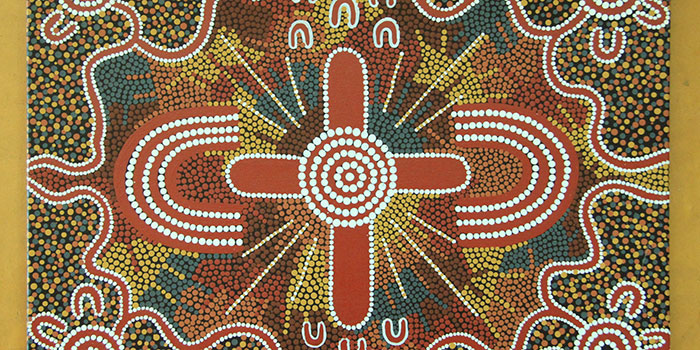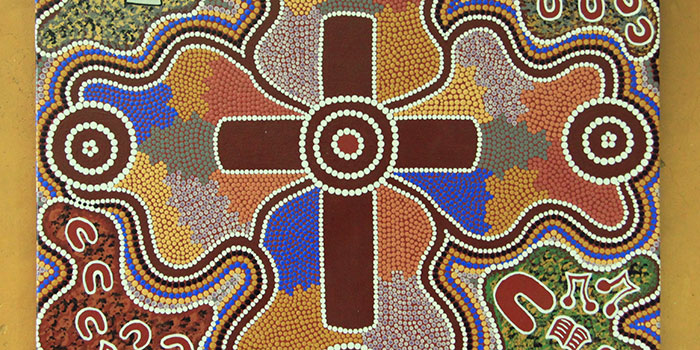Interview with Ruth Cook
Interviewed by Suanne Tikof
Ruth Cook is a Lutheran artist from Central Australia. Her Christian and secular art features themes and symbols from her Western Arranda culture.
Hi, Ruth. Can you tell me something about who you are, and your family?
Wurta (Hello). My name is Ruth Audrey Cook. I am a proud Aboriginal woman from the Western Arranda tribe of Central Australia. I was born in Alice Springs in 1982, and was adopted and raised by Elva Cook (nee Abbott) and her husband, Barry Cook. We lived at Intjartnama Outstation, about 20 kilometres from Ntaria (Hermannsburg).
I now live in Alice Springs with my partner Peter. We have been together for more than 13 years. We have three beautiful children – Laylah, Chloe and Peter Jnr. We are a very close little family.
What did you like about living out at Intjartnama?
Intjartnama is, and always has been, my home. I grew up there. I watched it grow. Mum and Dad, my brothers and sisters, our families all worked so hard to make our home, on our land. I liked living out at Intjartnama because it was safe and had lots of fun things to do, and I loved living with my family. We did so many things there together and it’s good to have lots of memories to tell your children.
Do you still go back there sometimes?
Yes, all the time. Intjartnama is just 120 kilometres from our house in Alice Springs. We get out there every week. I have two children at school in Alice Springs, so that makes it hard to be there every day. I want my children to know it is their homeland too.
Can you describe the country out there? What’s it like?
The country out there, it’s beautiful. At the moment it’s really green, because we’ve had lots of rain. We’ve got mountains, valleys, desert sands, desert hills – beautiful country to live on.
What about bush foods?
Plenty of bush tuckers out there. We have witchetty grubs, bush plums, bush tomatoes, bush onions, bush passion fruit, bush potatoes, bush figs, bush banana, sugar bags from the gums and wild honey ants.
And do the girls like bush tucker?
They sure do! They love trying any bush tucker we find – even kangaroo.
Can you tell me anything about your life as a Christian, Ruth?
Well I was baptised at Hermannsburg 1982. I’ve grown up seeing my families, like my mum and dad, my brothers and sisters, going to church. Especially my mum, she was a really strong Christian woman. She always used to take us to Sunday church out at Hermannsburg, or if we were in Alice Springs she used to take us to church. My mum always used to have a Bible with her and loved singing hymns from the hymnbook. That’s how I became a Christian, because of my mum. She taught me there’s two ways you can go: one way God’s way, and one way bad way. And I decided to take God’s way, by going to church, and now I’m teaching my kids.
How do you teach them about God?
Well I tell them stories from the Bible, I take them to church, and explain to them that when we go to church the pastor tells us stories of God. I read to the girls at night at home from the Bible, and tell them about God’s word.
What are your favourite Bible stories?
I enjoy the story of Adam and eve, the creation of human kind. I also like the story about the birth of Jesus.
How did you first become interested in painting, Ruth?
When I was young I used to watch a lot of my families and my mum all sitting around outside on the veranda of the house doing paintings. Then one day I sat down with the group and watched them and that’s how I became interested in doing painting.
Did anybody in particular teach you about painting? How did you learn?
I learned from my Mum Elva Cook. She taught me when I was six. She taught me what the symbols were and what sort of bush tuckers to do and how to do digging sticks and taught me the colours representing the trees and the rocks and the country. And I’ll treasure that for a very long time.
What I love the most is doing art. It’s what I’ve learned and I’ll continue doing it and teach my children’s too.
And what about the actual painting techniques? Who taught you how to prepare the canvas, what to buy, and how to create an artwork that will last?
Well, I went to secondary school at Yirara College, and I had a really good art teacher, Maurice Aladjem. He taught us Yirara students how to do art and taught us not only how to sell but also that you can buy your own art supplies.
Yirara College is a Lutheran Church school. Can you tell us a bit about that? What it was like going to school there?
Going to Yirara was a big change because we were away from families for so many weeks. We could go back on the weekends and holidays. It was a really good Christian school, strict, which I really liked because I was brought up strict by Mum and Dad. It was good to go to Yirara because you could learn independence for yourself to do things – learn to cook, learn making beds, brushing your teeth, going to school every day, meeting new people from different places and going out doing things. It was a good school.
Did going to Yirara, going to a Christian school, help you in your life at all?
Yes it has. Yirara has changed me in a lot of ways – it has made me have lots of friends like teachers and students from different Aboriginal homelands. It has made me a better person having so many friends.
After you finished your schooling at Yirara you worked in the school for a while. What did you do there?
I was an Art teacher and I taught young girls how to paint Aboriginal dot painting. I also helped Arranda students learn to read and write their own language in the Arranda literacy class.
So tell me a bit about what started you off doing Christian paintings.
Well what made me start doing Christian paintings was my mum. She said to me, ‘You should do a painting of Yirara College with a cross in the middle.’ From there I just continued doing paintings with crosses in them, showing the church in the middle, people coming to church from different communities, what happens in the church, and bush tuckers too.
Since then you’ve done a quite a few Christian paintings, haven’t you? You’ve done one for Finke River Mission, which they used as a poster a few years ago. And you’ve done one more recently for Lutheran Community Care. So how did those pictures happen?
The first one I did – Mr Irwin Traeger came out to Intjartnama one day and I had just finished a painting. It was with the 12 disciples and he bought it off me because he really liked it and a couple of months later he asked if he could use the painting to put it in the Christ in the Centre booklet. And he also made posters of it.
And what about the calendar for Lutheran Community Care?
That painting I just did one day in Alice Springs and a lady from the Lutheran church, Barbara Cybulka, (she runs the playgroup), asked if I had any Christian paintings. I said, ‘Yes, I do. It has bush tuckers on it.’ She saw the painting, fell in love with it, and asked if they could use it for a Lenten prayer calendar. And it turned out really good because there were forty bush tomatoes on the painting.
When you do your paintings you often use traditional symbols to tell the Christian stories. Are there any difficulties you have to overcome to put those two things together – the traditional symbols and the Christian story, or did you find that came naturally to you?
When Aboriginal people do painting, it comes with a story. I just found it came naturally because it’s the traditional way of doing painting. I just added in the cross and it all fits in perfectly together.
What do other Aboriginal people tell you about your paintings and the way they express Christian faith?
I get a lot of Aboriginal people commenting on my paintings. They find it really interesting how I did it and have a really good story to it. Some people will know straight away what the story is, or they might ask someone what it means.
In our church in Alice Springs there are a lot of traditional-style paintings around the walls. Do you think we could do anything more with those to help people understand Bible stories and their Christian faith?
Yes, we should use them because some people might understand it through a painting. It would be good to use them to make booklets so that people can understand them.
We could also use them in the service. For example, if there’s a painting up in the church and it matches with the reading, we could bring it down and put it in the front or have the artist there explaining. It’d be good to put those paintings in a book for kids or use them when kids go up and listen to the pastor.
It’s been great talking to you, Ruth. To finish, what do you hope your art will achieve, now and in the future?
Well, with my art, I want to continue doing it because it’s what I’ve learnt from my elders, especially my mum. It’s a hobby that I’ll do and teach my children and their children. I also teach young people and anyone that wants to learn.


